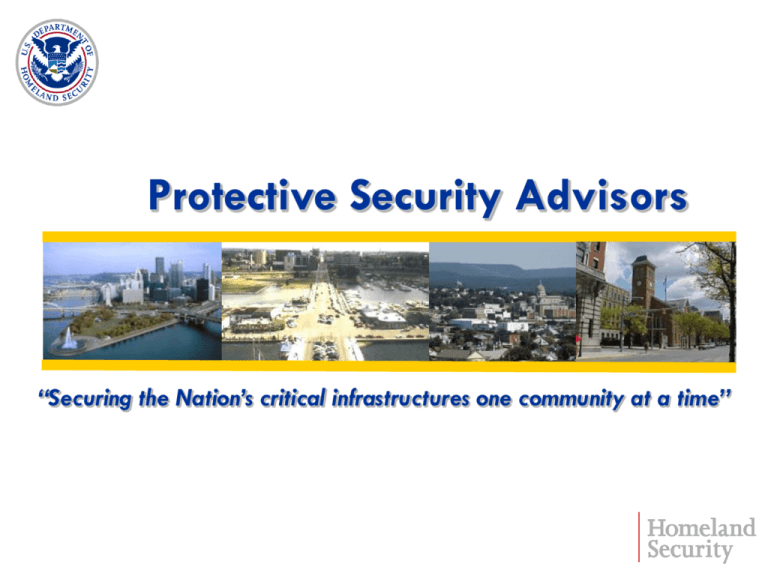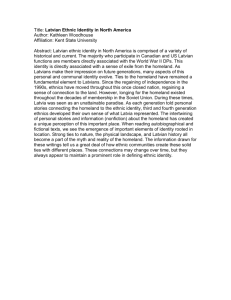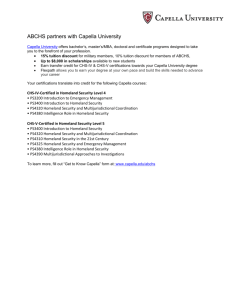DHS_Protective_Security_Advisors
advertisement

Protective Security Advisors “Securing the Nation’s critical infrastructures one community at a time” Communities Depend Daily on Reliable Systems These systems are the “invisible” critical infrastructure that our communities depend on every day, for example: Telephone systems that allow us to use ATMs/credit cards for our financial transactions, and real-time communications for business and personal use (cellular phones, pagers, e-mail, land-lines, and faxes) Electricity that allows us to light and heat our homes and businesses, and power computers and vital communication devices like radio and television Water systems that provide us with water for drinking, sanitary needs, irrigation, and firefighting capabilities Critical Infrastructure & Key Resource Sectors Critical Infrastructure Sectors Agriculture and Food Banking and Finance Chemical Defense Industrial Base Drinking Water and Wastewater Treatment Systems Emergency Services Energy Information Technology National Monuments and Icons Postal and Shipping Public Health and Healthcare Telecommunications Transportation Systems Key Resources Commercial Facilities Commercial Nuclear Reactors, Materials, and Waste Dams Government Facilities The Threat We will “hit hard the American economy at its heart and its core.” - Osama bin Laden Without doubt, terrorist groups recognize the economic ramifications of attacks on the Nation’s critical infrastructure and key resources. Dependency on our Critical Infrastructure & Key Resources… National Security Economic Vitality Our Way of Life Attacks Could… Disrupt government and private industry operations and impact our economy and society Result in large-scale human casualties, property destruction, and damage to national prestige and public confidence The Role of the Department of Homeland Security Unify a national effort to secure America Prevent and deter terrorist attacks Protect against and respond to threats and hazards to the Nation Respond to and recover from acts of terrorism, natural disasters, or other emergencies Coordinate the protection of our Nation’s critical infrastructure and key resources (CI/KR) across all sectors The Challenge to Protect Critical Infrastructure & Key Resources 85% of all CI/KR assets are privately-owned To help communities better protect the Nation’s assets, the Department of Homeland Security is placing Protective Security Advisors (PSAs) in metropolitan areas throughout the country The Department of Homeland Security must work with industry and Federal entities, as well as state, territorial, local, and tribal governments to protect CI/KR PSA Districts Region III PSA Districts PSA-Pittsburgh District Commonwealth of Pennsylvania Uniquely situated Has 720 bridges in the city Home to six Fortune 500 companies Over 1,700 in Allegheny County Critical Transportation Infrastructures Air Pittsburgh Int’l Airport • 3.7 million passengers each year • 437 flights per day Water Nation’s 2nd largest inland port Over 200 river terminals Water-related industries generated 217,000 jobs and more than $10 billion in revenue Over 200 miles of commercially navigable Rail Two Class-One railroads Conway Yards one of the most modern and sophisticated rail systems in the world Road Served by four U.S. interstate highways Pittsburgh Landmarks & Events 62 Stories 2.9 million rentable square feet 700-car underground parking garage Headquarters to Fortune 500 companies USX Tower David L. Lawrence Convention Center 1.6 million square feet of exhibit halls 2nd tallest education building in the world Cathedral of Learning Key Pittsburgh Sports Landmarks Beaver Stadium Seating capacity for 64,450 Seating capacity for 38,496 Seating capacity for 17,000+ Seating Capacity for 106,537 • Nation’s 2nd largest The Department of Homeland Security Provides Community-Based Support Protective Security Advisors will: Assist with ongoing local and state critical infrastructure security efforts which are coordinated by the state Homeland Security Advisors Support the development of the national risk picture by identifying, assessing, monitoring, and minimizing risk to critical assets at the local level Upon request, facilitate and coordinate vulnerability assessments of local CI/KR Provide reach-back capability to the Department of Homeland Security and other Federal government resources Protective Security Advisors Will Also… Assist in verification of critical asset information for accurate inclusion into the National Asset Database Serve as advisors regarding local infrastructure during activation of the National Response Plan Provide local context and expertise to the Department of Homeland Security to ensure that community resources are used effectively Facilitate the flow of programmatic information between all parties with a vested interest in CI/KR protection Work in state and local Emergency Operations Centers to provide expertise and support to the IP Infrastructure Liaison Cell, who supports the Principal Federal Official and Federal Coordinating Officer responsible for domestic incident management Protective Security Advisors’ Sector Coverage Although the Risk Management Division (RMD) has Sector-Specific Agency responsibility for Commercial Facilities and Dams, PSAs cover all 17 CI/KR sectors. Value of the Program to You Protective Security Advisors will: Support comprehensive risk analyses of local CI/KR Assist in the review and analysis of physical/technical security of local CI/KR Convey local concerns and sensitivities to the Department of Homeland Security and other Federal agencies Relay disconnects between local, regional, and national protection activities Communicate requests for Federal training and exercises Your PSA Can Also… Give guidance on established practices Provide local communities with access to updated Department of Homeland Security capabilities, including: • New tools and technologies • Best practices for protection and mitigation strategies • Expertise and experience within the Department of Homeland Security and other agencies • Expertise and experience from other PSAs based in communities with similar concerns Keep communities informed of national policy context and initiatives Provide support to officials responsible for special events planning PSA Activity To Date Includes. . . Establishing relationships with 8,000+ stakeholders on the Federal, state, territorial, local, and tribal level and within the private sector (since 14 March 2005) Supporting risk reduction activities, including the facilitation of Site Assistance Visits, the Buffer Zone Protection Program, as well as verification and technical assistance visits to CI/KR Attending numerous conferences and participating in large exercises and special events throughout the country PSA Activity Also Includes. . . Providing real-time situational awareness to the Department of Homeland Security/RMD leadership on incidents or areas of concern Supporting the response, recovery, and reconstitution efforts of those states affected by Hurricanes Katrina and Rita by: • Working with Principal Federal Officials and Federal Coordinating • • • • Officers in states’ Joint Field Offices Supporting representatives tasked to coordinate Emergency Support Functions of the National Response Plan Helping to coordinate Federal, state, and local law enforcement efforts regarding the protection of CI/KR Performing site visits for general damage and security assessments in coordination with RMD deployed teams Providing advice on protective measures How Can You Help? Engage with Protective Security Advisors to facilitate protective actions and establish priorities and the need for information Assist in efforts to identify, assess, and secure CI/KR in your community Communicate local critical infrastructure protectionrelated concerns • Business and economic ramifications of actions • Issues unique to the community PSA-Pittsburgh District psadutydesk@hq.dhs.gov





